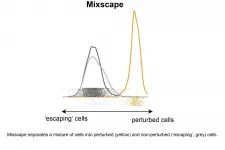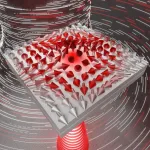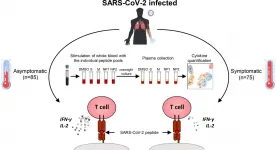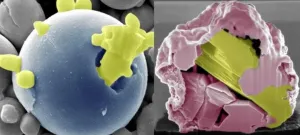(Press-News.org) A team of researchers from New York University and the New York Genome Center has developed a new computational tool to help understand the function and regulation of human genes. The results, published today in the journal Nature Genetics, demonstrate how to interpret experiments that combine the use of CRISPR to perturb genes along with multimodal single-cell sequencing technologies.
The article describes how the new approach, called mixscape, helped to identify a new molecular mechanism for the regulation of immune checkpoint proteins that govern the immune system's ability to identify and destroy cancer cells.
"Our approach will help scientists to connect genes to the specific cellular behaviors and molecular pathways that they regulate," explains Rahul Satija, the study's senior author, who is an associate professor of biology at NYU's Center for Genomics and Systems Biology and a core faculty member at the New York Genome Center.
The researchers set out to better understand how cancer cells alter the regulation of key genes, such as the immune checkpoint molecule PD-L1, in order to avoid detection and evade the body's immune system. To do so, they performed a pooled genetic screen, where they 'knocked out' a set of genes in a cancer cell line model in order to observe the effect of each change or perturbation on PD-L1 levels. They utilized ECCITE-seq, a technology that allows researchers to capture single-cell profiles of different types of biomolecules--such as RNA and protein--after perturbing each gene with a CRISPR "guide RNA." The ability to measure multiple types of molecular data, referred to as multimodal analysis, allowed the team to distinguish between transcriptional and post-transcriptional modes of regulation.
After completing its experiments, however, the team realized that significant computational challenges limited its ability to analyze and interpret the data. For example, the researchers found that when they tried to knock out the same gene in multiple different cells, they observed striking variability in the results. In particular, a substantial fraction of cells--up to 75% in some cases--appeared to escape any observable effects after attempted perturbation and represented a confounding source of noise in downstream analysis.
"Facing these challenges made us realize that we needed new computational methods to identify and remove confounding sources of variation in our dataset," says Efthymia Papalexi, a biology graduate student at NYU and lead author of the study.
To achieve this, the team developed a statistical approach--mixscape--to model each perturbation as giving rise to a mixture of cells with different responses. In doing so, the mixscape method can identify and remove sources of noise from the data, allowing the user to focus on the most important biological signals that remain.
"When we applied mixscape in our screen, we boosted our power to connect gene perturbations with changes in the transcriptome and protein expression. This allowed us to discover that the kelch-like protein KEAP1 and the transcriptional activator NRF2 mediate a cell's expression level of PD-L1," says Satija.
While these studies were conducted in cancer cell lines, KEAP1 and NRF2 are frequently mutated in human lung cancer samples, suggesting that these genes may play important roles in the development and progression of human tumors.
Looking forward, the researchers are leveraging multimodal single-cell pooled CRISPR screens and mixscape to understand the molecular regulation of dozens of additional pathways and cellular behaviors.
Mixscape is freely available online through the Satija lab's Seurat package, a software toolkit for biomedical researchers.
"We hope our method will be useful for the community and assist in the study of how genes and molecular pathways interact with each other," says Papalexi.
INFORMATION:
The work was supported by the Chan Zuckerberg Initiative (EOSS-0000000082, HCA-A-1704-01895) and the National Institutes of Health (DP2HG009623-01, RM1HG011014-01, R21HG009748-03).
The scientists have demonstrated how to structure light such that its polarization behaves like a collective of spins in a ferromagnet forming half-skyrmion (also known as merons). To achieve this the light was trapped in a thin liquid crystal layer between two nearly perfect mirrors. Skyrmions in general are found, e.g., as elementary excitations of magnetization in a two-dimensional ferromagnet but do not naturally appear in electromagnetic (light) fields.
One of the key concepts in physics, and science overall is the notion of a "field" which can describe the spatial distribution ...
A joint research team co-led by City University of Hong Kong (CityU) has developed a new soft tactile sensor with skin-comparable characteristics. A robotic gripper with the sensor mounted at the fingertip could accomplish challenging tasks such as stably grasping fragile objects and threading a needle. Their research provided new insight into tactile sensor design and could contribute to various applications in the robotics field, such as smart prosthetics and human-robot interaction.
Dr Shen Yajing, Associate Professor at CityU's Department of Biomedical Engineering ...
By analyzing blood samples from individuals infected with SARS-CoV-2, researchers in Singapore have begun to unpack the different responses by the body's T cells that determine whether or not an individual develops COVID-19. The study, published today in the Journal of Experimental Medicine (JEM), suggests that clearing the virus without developing symptoms requires T cells to mount an efficient immune response that produces a careful balance of pro- and anti-inflammatory molecules.
Many people infected with the SARS-CoV-2 virus do not develop any symptoms, and the infection ...
UNIVERSITY PARK, Pa. -- The rate of suicide among post-9/11 military veterans has been rising for nearly a decade. While there are a number of factors associated with suicide, veterans have unique experiences that may contribute to them thinking about killing themselves.
"Compared to their civilian peers, veterans are more likely to report having experienced traumatic adverse childhood experiences (ACEs) such as physical and emotional abuse," stated Keith Aronson, associate director of the Clearinghouse for Military Family Readiness at Penn State and the Social Science Research Institute ...
LAWRENCE -- A new study from University of Kansas journalism & mass communication researchers examines what influences people to be susceptible to false information about health and argues big tech companies have a responsibility to help prevent the spread of misleading and dangerous information.
Researchers shared a fake news story with more than 750 participants that claimed a deficiency of vitamin B17 could cause cancer. Researchers then measured if how the article was presented -- including author credentials, writing style and whether the article was labeled as "suspicious" or "unverified" -- affected how participants perceived its credibility and whether they would adhere to the article's recommendations or share it on social media. The findings showed that ...
AMES, Iowa - Inspired by nature's work to build spiky structures in caves, engineers at Iowa State University have developed technology capable of recovering pure and precious metals from the alloys in our old phones and other electrical waste.
Using controlled applications of oxygen and relatively low temperatures, the engineers say they can dealloy a metal by slowly moving the most reactive components to the surface where they form stalagmite-like spikes of metal oxides.
That leaves the least-reactive components in a purified, liquid core surrounded by brittle metal-oxide spikes "to create a so-called 'ship-in-a-bottle structure,'" said Martin Thuo, the leader of the research project and an associate professor of materials science and ...
A type of ultrasound scan can detect cancer tissue left behind after a brain tumour is removed more sensitively than surgeons, and could improve the outcome from operations, a new study suggests.
The new ultrasound technique, called shear wave elastography, could be used during brain surgery to detect residual cancerous tissue, allowing surgeons to remove as much as possible.
Researchers believe that the new type of scan, which is much faster to carry out and more affordable than 'gold standard' MRI scans, has the potential to reduce a patient's risk of relapse by cutting the chances that a tumour will grow ...
The amount of green space surrounding children's homes could be important for their risk of developing ADHD. This is shown by new research results from iPSYCH.
A team of researchers from Aarhus University has studied how green space around the residence affects the risk of children and adolescents being diagnosed with ADHD. And the researchers find an association.
"Our findings show that children who have been exposed to less green surroundings in their residential area in early childhood, which we define as lasting up until age five, have an increased risk of receiving an ADHD diagnosis when compared to children who have been surrounded by the highest level of green space," says ...
Anorexia nervosa, bulimia nervosa and binge-eating disorder are the three main eating disorders that 4 out of in 10 individuals living in Western Europe will experience at some point in their lives. In recent years, studies on the genetic basis of anorexia nervosa have highlighted the existence of predisposing genetic markers, which are shared with other psychiatric disorders. By analysing the genome of tens of thousands of British people, a team from the University of Geneva (UNIGE), the University Hospitals of Geneva (HUG), King's College London, the University College London, the University of North Carolina (UNC) and The Icahn ...
Research from the University of Kent has led to the development of the MeshCODE theory, a revolutionary new theory for understanding brain and memory function. This discovery may be the beginning of a new understanding of brain function and in treating brain diseases such as Alzheimer's.
In a paper published by Frontiers in Molecular Neuroscience, Dr Ben Goult from Kent's School of Biosciences describes how his new theory views the brain as an organic supercomputer running a complex binary code with neuronal cells working as a mechanical computer. He explains ...



